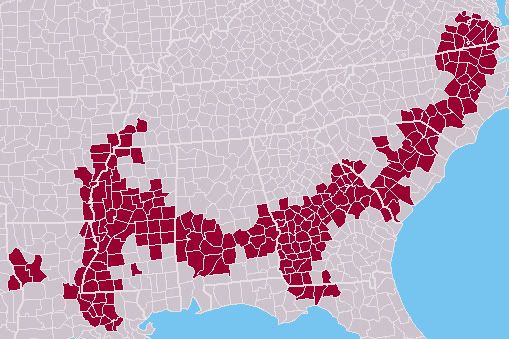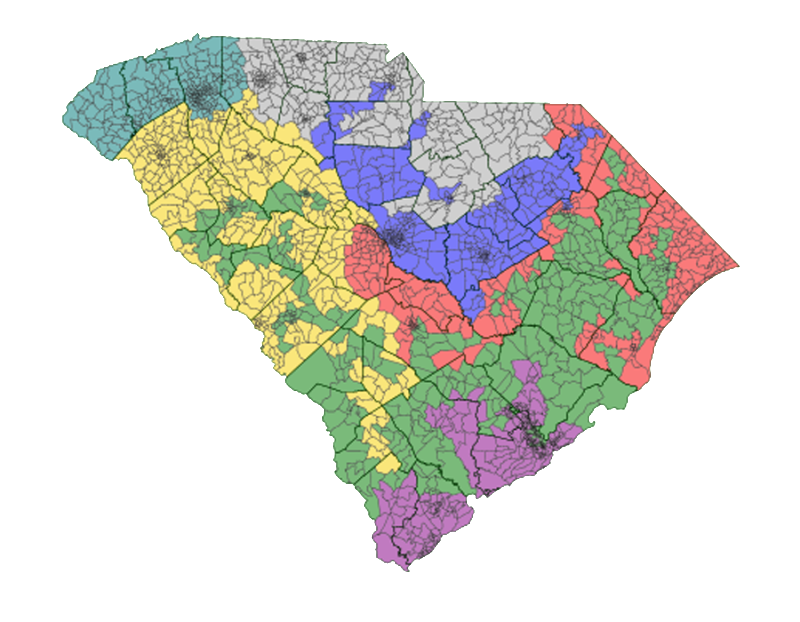Here is my take on an 8-0 Maryland. I must thank abgin for this incredible inspiration of using stripe-style gerrymandering (the famous map he did of NY). I employed this technique in reverse – I asked myself, how can I link all of these heavy Dem areas to Republican areas to dilute their votes? I thought of where their votes are concentrated, and the biggest source is Northern Maryland and the Baltimore Suburbs.
So, I set out to link Dem heavy areas to Republican areas in Northern Maryland, and it worked well. The map is not too bad looking, although Ruppersberger and Sarbanes would have trouble fitting into this map, but they can move. Hoyer and Van Hollen would have decent district and maintain a lot of their territory. Barlett and Harris are completely drawn out, and I managed to make two VRA districts that are 51% black, while they take in as many heavy R precincts as possible in Northern Maryland the Baltimore Suburbs so they can leave liberal white areas and other AA areas to shore up other districts.
I wanted the Obama-McCain lean to be roughly 60%-40%, and I did well in that regard, I think only one is 57% Obama and the rest are over 58% Obama, so all districts are around D+5 to D+8, with the VRA districts being more Dem heavy. The only district I think that would be in trouble would be the Eastern Shore based one, but if Kratovil runs, it is his. So, here you go!
Below is the state as a whole. The CDs aren’t numbered well on my map, since I ended up editing a lot, so I’ll just leave the CD numbers off the map and make different numbers.

CD1 in Perriwinkle: Panhandle. Hagerstown, Frederick, Potomac – This district is similar to the ones others have posted to make this district less friendly to Barlett (currently the 6th.) There is no way he would win this district. This has much of Van Hollen’s 8th district, so I would assume he would run here. If he doesn’t live here, the move isn’t far. (Pictures are below)
Obama:59% McCain:40%
White:70% Black:10% Asian:9% Hispanic:8%
CD2 in Grey: Silver Spring and DC burbs extending to Northern Border – The worst thing about this district is that there seems to be no clear incumbent here. Cummings would move to a VRA district, Van Hollen would want the 1st (he could take this if he wants too I guess, his choice) so I suppose this would be a new Democratic Representative. Bartlett could try running here, but I doubt he’d come close. Fairly neat looking district.
Obama:60% McCain:38%
White:61% Black:13% Asian:8% Hispanic:16%

CD3 in Dark Green: College Park, Columbia and the Northern Border – Takes in heavily Dem areas in the DC burbs, through Columbia and then sucks up heavily R areas up north on the border. This district also presents a huge problem for current reps. I guess Ruppersberger may be willing to make the move… Cummings again wouldn’t be here, and there really is no one else who I can see running here.
Obama:59% McCain:39%
White:55% Black:24% Asian:8% Hispanic:11%
CD4 in Green: Eastern DC suburbs stretching to Baltimore Suburbs – The challenge I had with this map in general was diluting suburban Baltimore while keeping two majority black districts. This was one part in solving that problem. I was able to keep this 51% AA while stretching it from heavily AA precincts outside of DC to heavily Republican areas South and East of Baltimore City. This district does take a lot of the AA territory from Donna Edwards current district, MD-4, so she should run here and be safe.
Obama:72% McCain:27%
White:41% Black:51% Asian:2% Hispanic:5%
CD5 in Purple: Southern Maryland to Annapolis– This district pretty much drew itself after the two black majority districts were drawn. I could take remaining AA precincts outside of DC, pull them in with rural more R leaning areas in Southern Maryland, then bring them to Annapolis naturally. Steny Hoyer would have a lot familiar territory, but now he gets Annapolis and AA areas outside of DC instead of areas NE of DC. Still should be a fairly easy hold for him.
Obama:60% McCain:39%
White:62% Black:30% Asian:3% Hispanic:4%


CD6 in Yellow: Northern Baltimore, Baltimore Suburbs, down to liberal areas northeast of DC– One of the nastier districts, this links two areas of Dem strength leftover from other districts – liberal areas between DC and Baltimore, and northern parts of Baltimore itself. I was able to perfectly combine these, while incorporating Baltimore burbs to dilute Republican votes while keeping this district solidly Dem leaning. Maybe Sarbanes would move to this district? Or Ruppersberger? Those two really are the odd men out in general. since their current districts are disgusting. If they want their jobs with this map, they need to move.
Obama:58% McCain:40%
White:63% Black:26% Asian:6% Hispanic:4%
CD7 in Blue: Western Baltimore City, Baltimore Burbs and Rural areas in Northern Maryland. – I had a hard time trying to keep this at 51% black while at the same time sucking up as much anti-Obama votes as possible. To do this I had to find the anti-Obama votes (much like abgin did in NY, where he drew all districts to NYC to find Dem votes.) Once I adopted that strategy, I was able to do the wrap-around kind of districts near Baltimore for CD6 and CD7 in my map. This naturally gave way to making all districts have a north-south orientation in order to dilute Republican strength in Rural North Maryland. Cummings keeps a lot of his old territory in Baltimore, so this district would fit him nicely.
Obama:71% McCain:27%
White:42% Black:51% Asian:3% Hispanic:3%
CD8 in Red: Eastern Shore stretching to Baltimore City– I’m sorry I divided you into 4 pieces, Baltimore. But Kratovil would love this district. It is fairly Democratic, even someone more liberal than Kratovil can win here. But this would be a perfect fit for him. Harris would never win. I did use a tiny, TINY bit of water contiguity near Perryville where the shore meets to mainland in a U-shape (you can kinda see it, its not too bad.) I did this to keep the district from having to take in a couple R-heavy precincts, and the district honestly doesn’t look any worse than any MD district currently.
Obama:57% McCain:42%
White:66% Black:27% Asian:2% Hispanic:3%














